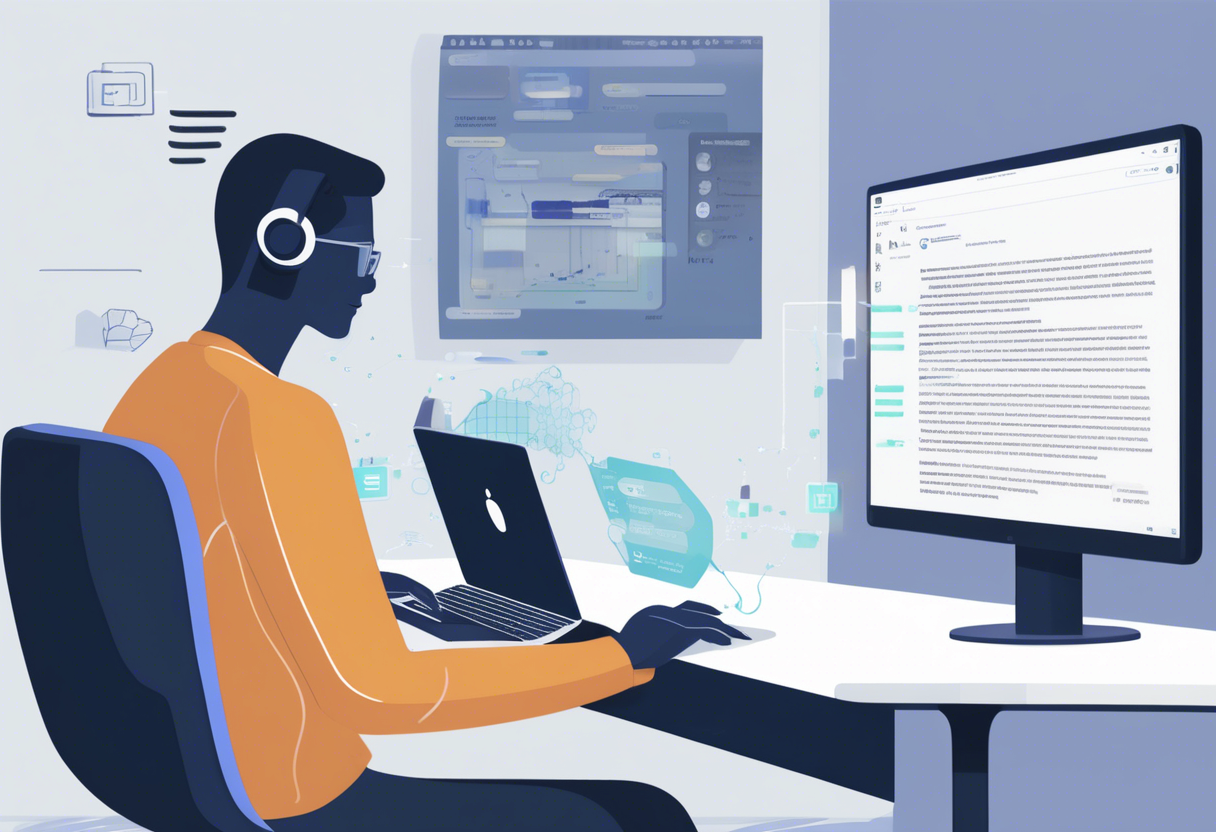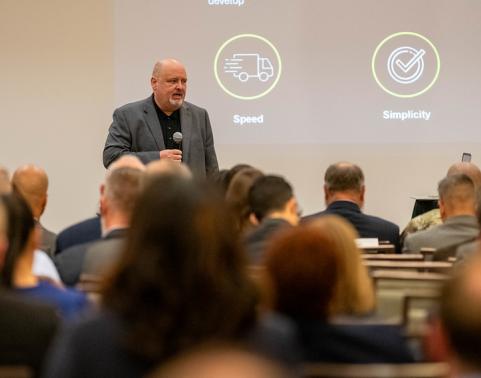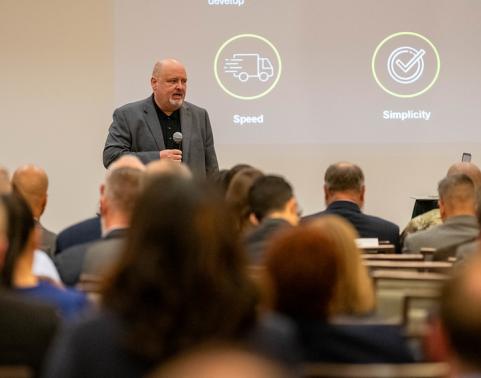In our fast-moving digital world, good workplace communication is key. You might find it interesting that companies with solid communication plans see 25% less employee turnover. As businesses aim for better teamwork and productivity, AI is stepping in to change the game. It’s not just about making communication smoother; AI can even spot misunderstandings before they happen. In this article, we’ll look at how AI can boost workplace communication, covering its perks, real-world uses, and the ethical questions it brings up. Whether you're a leader wanting to improve team dynamics or an employee curious about what's next, you'll find useful tips and strategies here. So, let’s see how AI might change the way we connect and work together.
Summary: Dieser Artikel beschreibt die Rolle von KI bei der Verbesserung der Kommunikation am Arbeitsplatz, einschließlich der Vorteile, praktischen Anwendungsfälle, Herausforderungen und ethischen Überlegungen sowie umsetzbarer Strategien für die Implementierung.
AI's Role in Enhancing Workplace Communication: Key Insights
AI in Workplace Communication: Transformative Impacts
AI is transforming the way we communicate and collaborate in the workplace. It offers valuable insights into employee productivity and engagement, facilitates rapid content creation, and enhances mutual understanding across language barriers. Think of AI as a personal assistant handling tedious administrative tasks, thereby streamlining teamwork and allowing us to concentrate on what truly matters. This concept is elaborated in the Appspace Blog.
AI tools are particularly beneficial for collaborating with colleagues across different time zones and languages. These tools help personalize interactions, ensure consistency, and check for errors in communication. For more on this, refer to the Zoho Blog.

While AI-generated messages are time-saving and maintain consistency, they may lack emotional understanding and raise privacy concerns. The Backstitch Blog recommends using AI to complement human communication, emphasizing the importance of vigilance and a people-centric approach.
Moreover, AI and automation enhance efficiency by eliminating repetitive tasks, making communications more relevant, and providing real-time insights to refine strategies. This is further discussed in the Staffbase Blog.

Benefits of AI in Workplace Communication
AI-Driven Automation and Efficiency
AI is revolutionizing workplace communication by automating repetitive tasks, streamlining processes, and enhancing productivity. Here's how:
-
Automating Routine Tasks: AI takes over tasks like scheduling emails and sending reminders, allowing you to concentrate on larger projects. This not only saves time but also reduces busywork, significantly boosting productivity.
-
Seamless Integration: By integrating different communication platforms, AI minimizes administrative hassles, facilitating smoother collaboration and ensuring everyone stays connected.
Tools like real-time transcription services, such as Otter.ai, eliminate the need for manual note-taking during meetings. They automatically convert spoken words into text, providing accurate notes and summaries effortlessly.

AI-Powered Personalization and Engagement
AI enhances workplace communication by personalizing interactions, which in turn boosts engagement. Here's how it works:
-
Tailored Messaging: By analyzing interaction patterns, AI sends messages at optimal times, in the ideal format, and with content tailored to different groups. This approach ensures inclusivity and relevance for all recipients.
-
Customized Responses: Tools like Salesforce Einstein analyze employee preferences and behaviors to provide personalized content and suggestions that resonate.
AI language translation tools also enable effective communication across global teams, breaking down language barriers and ensuring alignment.
Data-Driven Insights for Workplace Communication
AI excels at extracting valuable insights from vast amounts of data, significantly enhancing workplace communication. Here's how these insights can be leveraged:
-
Optimizing Communication Channels: By identifying areas for improvement, AI helps organizations manage their communication channels more effectively. For instance, tools like Slack utilize data to boost team interaction and efficiency.
-
Understanding Employee Sentiment: AI-powered sentiment analysis tools provide managers with insights into employee morale by analyzing feedback across various channels. This helps address issues and improve workplace atmosphere.
AI's predictive analytics also anticipate communication trends, enabling companies to adapt their strategies proactively.
In summary, AI's data-driven insights empower organizations to make informed decisions that enhance workplace communication. This not only boosts efficiency but also fosters a more connected and engaged workforce. According to a Slack report, 80% of employees using AI tools experience a productivity boost, particularly in writing assistance, workflow automation, and data analysis. Additionally, research indicates that 81% of employees report improved job performance with AI, and 68% desire more AI-driven solutions in the workplace.
Practical Use Cases of AI in Workplace Communication
AI in HR and Benefits Communication
AI tools are revolutionizing HR communication by automating repetitive tasks. These tools can:
- Generate personalized information about employee benefits.
- Send timely reminders to ensure employees receive the necessary information promptly.
This automation ensures that employees are well-informed without unnecessary delays. Additionally, AI analyzes employee engagement and satisfaction, helping HR teams craft messages that resonate with their audience. For instance, AI chatbots can instantly address benefit-related inquiries, reducing the workload for HR staff and providing employees with accurate, round-the-clock answers. In complex situations, these AI chatbots seamlessly transition the conversation to a human HR representative, maintaining a smooth and personalized experience.

AI-Driven Internal Communication Enhancements
AI is transforming internal communication by enhancing speed and quality. Tools like Copilot can create engaging email subject lines, increasing open rates and streamlining communication processes. AI excels at rapid data analysis, allowing communicators to concentrate on strategic and creative tasks. It also refines content across teams by improving grammar, clarity, and engagement. This ensures that internal messages are not only clear and professional but also captivating and impactful.
AI Solutions for Remote and Hybrid Workforces
AI plays a crucial role in enhancing communication for remote and hybrid teams. AI-powered noise cancellation tools significantly improve audio clarity during calls, enhancing communication quality. Moreover, AI-driven collaboration tools facilitate seamless interaction among team members, whether they are in the office, at home, or a combination of both. Tools like Otter.ai provide real-time transcription, making meetings more productive for remote teams. These transcriptions ensure that everyone has access to meeting content, regardless of time or location.

AI is significantly advancing workplace communication, making it more efficient, personalized, and inclusive. As workplaces continue to evolve, AI's role will expand, ensuring smooth and effective communication. From automating HR tasks to enhancing internal communication and supporting remote work, AI is reshaping how we communicate and collaborate. By leveraging AI, companies can ensure their communication strategies are not only effective but also innovative and prepared for the demands of the modern workplace.
Challenges and Ethical Considerations
Drawbacks of Poor Workplace Communication
Poor communication at work can significantly disrupt operations. It often leads to misunderstandings, conflicts, and a breakdown in teamwork. These issues can slow down productivity and cause employees to feel unappreciated and disconnected.
For instance, when management provides unclear instructions, it may result in repeated mistakes and frustration among team members. This can delay projects and lead to missed opportunities. Moreover, communication failures might lead to duplicated work, further reducing productivity.
Ego and attitude issues can also pose significant challenges. Dominating discussions or refusing to compromise can create resentment and tension among colleagues. Additionally, a lack of motivation or interest can result in employees ignoring messages, leading to about a 17% drop in productivity compared to their motivated counterparts.

Poor listening skills, such as not paying attention or interrupting, exacerbate these gaps and misunderstandings. Furthermore, issues like poor writing, using inappropriate communication tools, or oversharing can contribute to a toxic workplace environment.
Ethical Workplace Communication
Ethical communication at work is essential for maintaining respect and fairness. Addressing attitude and ego issues in communication helps prevent individuals from dominating or excluding others from discussions.
Regular, constructive feedback is crucial for employee growth and for preventing feelings of neglect or undervaluation. Offering diverse communication methods respects varying preferences and needs, fostering a more inclusive workplace. Ethical communication involves genuinely listening and being empathetic to understand others' perspectives, which helps avoid misunderstandings or resentment.
Key principles of ethical communication include honesty, transparency, and respect. Honesty builds trust and aids in identifying issues related to authority and teamwork. Transparency involves being clear, adhering to rules, admitting mistakes, and sharing sources. Respect entails being sensitive to cultural and gender differences, actively listening, offering affirmations, and using inclusive language.

Ethical communication also involves protecting client and public data, complying with regulations like GDPR, and promoting openness and inclusion.
Integrating Human-AI Interaction in Workplace Communication
To prevent communication breakdowns, companies should establish clear rules for using various communication channels, including AI tools, to avoid confusion. AI can enhance workplace communication by facilitating real-time collaboration and managing information overload when integrated with platforms like Microsoft Teams or Google Workspace.
Training employees in effective communication techniques, including the use of AI tools, can improve overall workplace communication.
Balancing human empathy with AI efficiency involves encouraging open dialogue and feedback to maintain engagement and address emotional nuances that AI might overlook. For example, a company might utilize AI chatbots for routine inquiries but ensure that human managers provide personalized feedback and handle sensitive discussions to preserve trust and morale.
Encouraging a culture of continuous learning can help employees adapt to new technologies and leverage AI to enhance their work. By fostering an environment where AI and humans collaborate effectively, companies can optimize communication and boost productivity.
Actionable Strategies for Implementing AI in Workplace Communication
AI-Driven Personalization Techniques
In today's workplace, personalization is key to keeping communication clear and engaging. AI assists by customizing messages to fit different roles, preferences, and past interactions, ensuring they resonate more effectively. With AI-powered analytics, companies can assess the efficacy of their communication through insights such as sentiment analysis and engagement trends, allowing for proactive improvements.

Integrating AI with tools like email, mobile apps, chat, and intranet ensures messages are delivered at the optimal time and place. This reduces unnecessary noise and boosts engagement. AI segments audiences based on roles, interests, and behavior, ensuring each person receives the most relevant message. This intelligent use of AI fosters a communication environment that's inclusive and responsive to everyone's needs.
AI can also automate message customization by analyzing past interactions to determine the best communication approach for different team members. Some individuals might prefer concise, bullet-pointed emails, while others might favor detailed narratives. AI can function like personal assistants through chatbots, adapting to user preferences over time and refining responses—such as suggesting optimal meeting times, summarizing lengthy documents, or translating messages into a preferred language.
Effective AI Adoption Strategies for Diverse Workforces
Introducing AI into workplace communication requires careful planning, particularly with diverse workforces. A strategic approach is to pilot one AI feature, such as personalized digests, and share successful outcomes to build trust. Training managers and employees to comprehend AI insights is crucial, emphasizing that AI is designed to support, not replace, human decision-making.

Developing comprehensive AI training programs helps employees understand the basics of AI and its impact on business communication. These programs should include hands-on workshops, online tutorials, and ongoing support, allowing everyone to learn at their own pace. By involving employees in AI adoption and decision-making, companies can enhance buy-in and ease the transition to AI-enhanced communication.
AI Best Practices for Engaging Virtual Teams
Virtual teams face unique challenges, but AI can help bridge the gap. One recommendation is to use AI to manage routine communication tasks, freeing up time for more strategic projects. It's essential to ensure AI tools integrate seamlessly with existing systems and workflows, which might require assistance from IT or tool customization.
Regularly evaluating the effectiveness of AI communication tools and providing ongoing training helps companies adapt to changing needs. AI can deliver personalized updates and recognize achievements in virtual teams, enhancing morale and engagement. For instance, AI-powered analytics can monitor team engagement levels and identify areas needing attention, offering insights into communication patterns and aiding leaders in understanding team interactions.
AI can also enhance virtual meetings by providing real-time transcriptions and translations, eliminating language barriers. Tools like Otter.ai and Microsoft Teams offer transcription features that make meetings more inclusive. By adopting these AI-driven practices, companies can create a more dynamic and connected virtual team environment, ensuring everyone feels valued and engaged, regardless of their location.
FAQ Section
How Can AI Boost Workplace Communication and Employee Engagement?
AI platforms can significantly boost employee motivation and engagement by personalizing communication and recognition. By offering feedback and encouragement tailored to each individual, these platforms help sustain high motivation levels. For instance, AI can analyze communication patterns and emotional cues, enabling managers to identify and address issues before they escalate. This proactive approach maintains a positive workplace environment.

AI also plays a role in keeping employees on track with their goals and deadlines by sending reminders and nudges. Imagine AI chatbots delivering personalized motivational messages or deadline reminders—this support makes employees feel valued and appreciated. These AI strategies foster a more engaged and motivated workforce by providing timely and personalized support.
What Are the Downsides of Over-Reliance on AI in Workplace Communication?
While AI brings numerous benefits to communication, over-reliance on it can have drawbacks. A significant concern is the reduction of genuine human interactions, which are crucial for building trust and rapport among team members. AI tools may also misinterpret tone or context, leading to misunderstandings or frustration if not monitored by humans. AI lacks the ability to fully comprehend the nuances and emotions inherent in human communication.
Excessive automation might leave employees feeling undervalued or disconnected from the company, negatively impacting motivation and engagement. Organizations that depend solely on AI for feedback may miss the empathy that comes from direct human communication. Therefore, balancing AI with human interaction is essential to maintaining a healthy workplace atmosphere.
How Does AI Enhance Workplace Communication Efficiency?
AI enhances internal communication efficiency through automation and data analysis. AI chatbots and virtual assistants can manage routine inquiries and disseminate information, allowing employees to focus on more complex tasks. This enables human resources to concentrate on areas requiring critical thinking and human judgment.

Moreover, AI can analyze vast amounts of communication data to identify trends, bottlenecks, or gaps, assisting organizations in refining their strategies. Automated scheduling, reminders, and follow-ups ensure timely and consistent dissemination of important messages. For example, AI can automatically schedule meetings, send reminders, and summarize key discussion points, streamlining internal communication.
In summary, while AI can significantly enhance workplace communication by boosting motivation, streamlining processes, and providing insights, it is crucial to integrate human oversight to address potential downsides.
Explore more on how AI can personalize communication and recognition, analyze employee sentiment, and automate reminders. However, be aware of the challenges posed by over-reliance on AI, underscoring the need for a balanced approach.